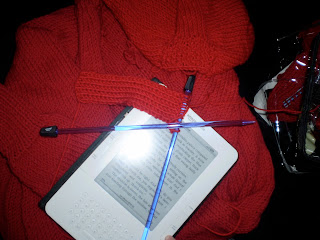My husband recently (okay like a month ago) officially promoted to Master Sergeant. It is a big deal and I am very proud of him. When he finally got to put his new rank insignia on he announced it on Facebook (again, what else would he do?) and said it a little something like this:
"...finally sewed on my new rank as MSgt (E-7)..."
When I spoke to my Mother that night she asked "Why did he say
he sewed on his new rank? You sewed it on!"
Which is true. While my husband is working very hard to be the best Senior NCO he can be by working even harder than before, putting in even more hours, and striving to be a good example of USAF for me the new promotion means sage green thread and new patches.
On base it costs five dollars a sleeve to sew on a new patch. My husband has five or six blue shirts, two ABU blouses and two jackets. Five dollars a sleeve adds up quick so, since I have the fancy new sewing machine, I got to sew them on myself.
Looking online there aren't any best practices for sewing rank patches on. Probably because, while it is a time consuming and detailed task, it's pretty easy. However, for all you other spouses out there who are celebrating a promotion with thread here is how I do it:
1) I cheat. There are a lot of very specific rules to the size of rank. For instance on an ABU men wear the large insignia, women the small. However, on the service dress everyone wears the small patch on the shirts and men wear the large on the jackets. This is all very confusing so I make my husband look it up and just tell me what to buy.
2) I cheat some more. Again, the placing of the patch is pretty specific and needs to look really neat. Since I was changing the patches from TSgt to MSgt I just cheated. I placed the MSgt patch over the TSgt patch matching the bottom curve and the bottom corners. I lined the point of the "roof" with the dip of the "wings" to find the center (which ought to go right down the crease of the shirt). Then I tacked everything down at the corners with contrasting thread. Start at the bottom corners and add an extra stitch in the middle of the curve. Then move up to the upper corners. These won't line up with the previous patch because you're (hopefully) adding an extra stripe or roof so the patch is bigger.
2a) Tacking might seem like an unnecessary step where you could just pin the patch in the middle, but sleeves are tricky to maneuver in a machine and the patch has to be centered and straight so those extra hand-stitches will make life so much easier later.
2b) You can't tacked the new patch over the old patch on blues. ABU's (or the new ones at least) aren't supposed to be ironed so the patches will come off easily in the next step. On blues the shirts have probably been ironed, dry-cleaned, steamed, and starched multiple times. Surprise! All of that glues the patch onto the sleeve. You will have to take the patch off first. However, the patch also dyes the shirt underneath and you have a lovely pattern of where the old one was placed. Use that to mark where the new patch should go and tack away.
3) Remove the old patch from underneath the new one. I love seam rippers!
4) Sew it on. I start with a straight edge them work slowly down. End at a straight edge too...it makes the back stitching easier. Stitch at the "seam" between the rolled thread edge and the background fabric of the patch. That way no one can see where you sewed it on.
4a) I use matching thread for the patches, but I realized after removing the old patches that the "professionals" just use black for everything. At least they do in Korea. I don't recommend it. If you make a mistake and go offline a little it won't show with matching thread.
5) Snip threads off. Then snip again. Then snip again. Threads are bad.
6) If it's an ABU congrats, you're done. If it's a blues shirt iron the sleeves down the middle and get a good crease in the patch. Then do it again. And again. You'll probably have to do this every time it's worn for awhile. It's hard to get that crease into the patch.
7) Okay, now you're really done and you saved some money. Yey.





